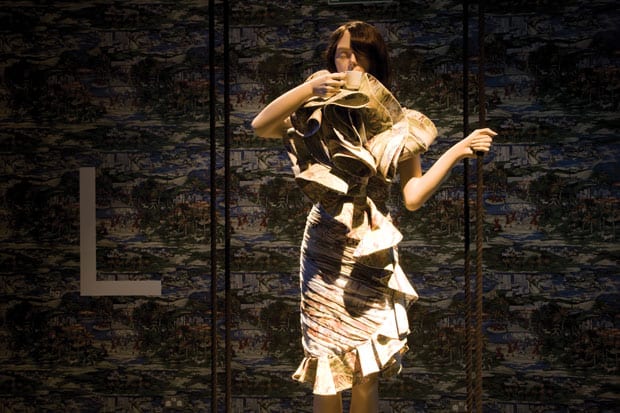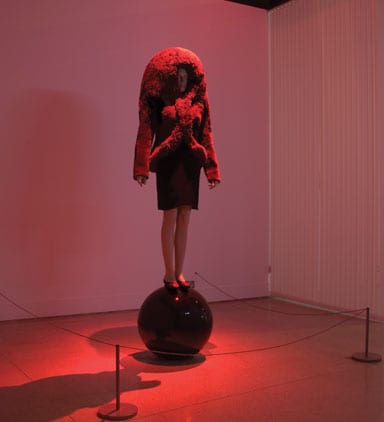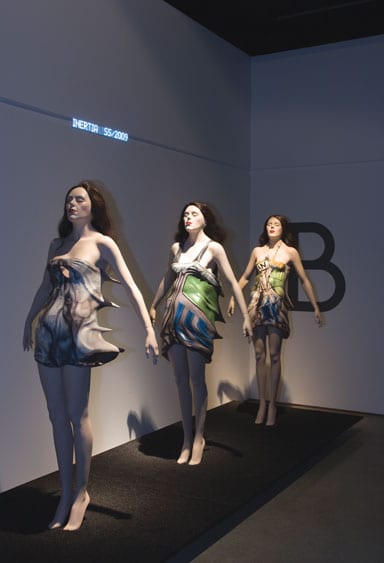
words Alistair O’Neill
Clothing as pure spectacle proves to be a crowd-pleaser as the Design Museum gives one of our most important fashion designers a retrospective, writes Alistair O’Neill.
As those lucky enough to have witnessed one of his fashion shows know, an intellectual engagement with design as well as a love of pure spectacle are the two attributes that mark Hussein Chalayan out. So it was no surprise to find an impressive turn-out for the opening reception for his retrospective at the Design Museum.
“Chalayan uses clothing as a site of exploration, to express concepts and make them accessible to a wider audience,” the exhibition blurb says. “He creates event spaces in the form of films, installations and exhibitions, as well as experimenting with new and innovative materials and techniques.” It’s clear from the off that this exhibition is seeking to engage with Chalayan’s chief conceptual concerns: how clothes are not just for wearing, but articulate space as well as form. To this end, the exhibition contains a wealth of projections, sculptures, photographs, set designs and tableaux, as well as the range of clothing designs from the designer’s career to date.
A beautifully distressed dress from Chalayan’s 1993 graduate collection provides a taste of the radical innovations to come. Here we see a dress scored through with rust. Chalayan had buried the clothes in a mixture of earth and iron filings. You are then immediately confronted by three mannequins in front of a wind machine sporting arresting showpieces from Chalayan’s latest collection, Inertia (2009), clothes inspired by the shape a body might make in the propulsion of a car crash. In bringing us up to date, the exhibition rightly highlights recent work that is less examined than the designer’s greatest hits.
What’s interesting about this exhibition is the discrepancy between an outfit we think we know by its image and its physical reality. In the well of the museum’s staircase is an outfit from Kinship Journeys (2003) that was originally modelled on a trampoline. It has two black helium balloons tethered to the shoulder straps of the black, gymslip-like garment. Chris Moore’s famous photo of the model seated on the trampoline is in the exhibition guide, and we recognise it as one of the most memorable images of Chalayan’s career. But seen here on a mannequin we observe the finer details of the piece. We see the small, richly embroidered patch of fabric at the midriff with a zip at its side, like a pocket for a keepsake. So the unexpected use of a traditional Turkish textile is suddenly imbued with themes of migration and memory, creating a sense of poignancy in an outfit seemingly in flight.
Chalayan is deft in his handling of decoration: unorthodox layers of fastenings and zips; precisely shaved tulle; and pattern-on-pattern effects. We see a detailed use of texture that is richer and more varied than his pared aesthetic suggests.
But still, something is missing from this exhibition. It is constrained by a format unable to capture Chalayan’s vision, a vision that, in its interdisciplinary scale, exceeds the conventions of a fashion retrospective. So, not matter how playful the title, how ingenious the labelling, or readable the guide, we lack a broader set of coordinates. It’s also unfortunate that a further set of references are missing, the credits of collaborators such as graphic artists Rebecca and Mike, product designer Michael Anastassiades and technology designer Moritz Waldemeyer.
For a designer who prizes interconnectedness as central to his creative practice, From fashion and Back succeeds in showcasing Chalayan as a great designer. But, in fact, he is much more than that.
Hussein Chalayan: From Fashion and Back is at the Design Museum, London, until 17 May



















